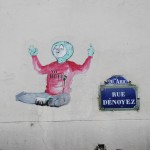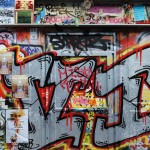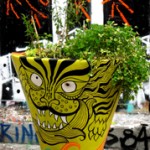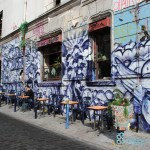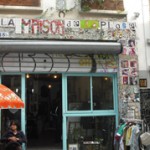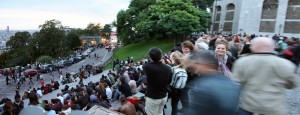Far away from the city center with the Eiffel Tower and Notre Dame, with fashion girls and thousands of tourists, far away from Haussmannisation and Gran Boulevards you can find Rue Dènoyez in the 20th arrondissement of Paris. When you enter the tiny street, the creature painted next to the street sign tells you “No rules” and soon you will realize, this street follows no rules. It doesn’t follow the rules of the city center, because you hardly will find here a Creperie or a guy, who is selling flashing Eiffel Towers. Neither does it follow the rule of the neighborhood Belleville.
Belleville was one of Paris’ working class neighborhoods, before it became in the 1980’ a new home for immigrants. If you take a walk through the streets of Bellville today, you will find a strange mixture of a Parisian china town, streets, which are marked by North African Kebab stores and shops for prayer mats. On the other hand you can also find chic street cafés, where the bolt and the beauties can enjoy their brunch on a sunny Sunday. Edith Piaf grew up in this neighborhood and films like “La Vie En Rose” or “Monsieur Ibrahim et les fleurs du Coran” are shot here. Belleville has undergone much gentrification in the last years and sometimes it seems that there is a clash of the old and the new Belleville. All this doesn’t count anymore if you walk through the beautiful Rue Dénoyez. Immediately you get caught by the colorful graffiti and wall paintings, which make it impossible to just pass by.
Looking further into this street you notice that not one thing is left unpainted. Doors and windows are transformed into artwork or are connected through a painting. Even dustbins and a hole in the wall are included in the creations and the pavement is covered with paint stains. What once must have looked like an ordinary street is now dominated by unique street art.
An explanation for this all is presented a few houses down the street. Next to what looks like a small shop called La Maison de la Plage, a placard is cemented into the wall saying that this workshop was founded by M.J Caprasse and others but soon became a meeting place for all the people of the neighborhood who need a place to work, a place of representation or to hold reunions and party’s. La Maison de la Plage is a voluntary association, started up in 2001, with the goal of using, in a collective and creative way, the empty spaces of the city. Intrigued by concepts of exchange, ecology and art and play, they are convinced of the need for contemporary poetry.
After you have red this and have spoke to the people it is clear that you have stumbled on a project that can serve as a great example of our ‘European Urban Cultures’ programme. The artists of La Maison de la Plage work together with the neighborhood and try to turn their living space into a place where people meet and can connect with each other. Workshops are held and street parties are organized. (More information about La Maison de la Plage can be found on their blog http://lamaisondelaplag.canalblog.com/.)
Of course a first impression can’t discover all pros and cons of such a project, but in this case it seems that sometimes if you don’t follow the traditionally given strategies, which are created by the authorities, but instead just start something by your own, collect different ideas and let the people around you be a part of it, the outcome of such a project can be very fruitful.
So sometimes “No rules = better rules”?
By Valérie and Valerie

